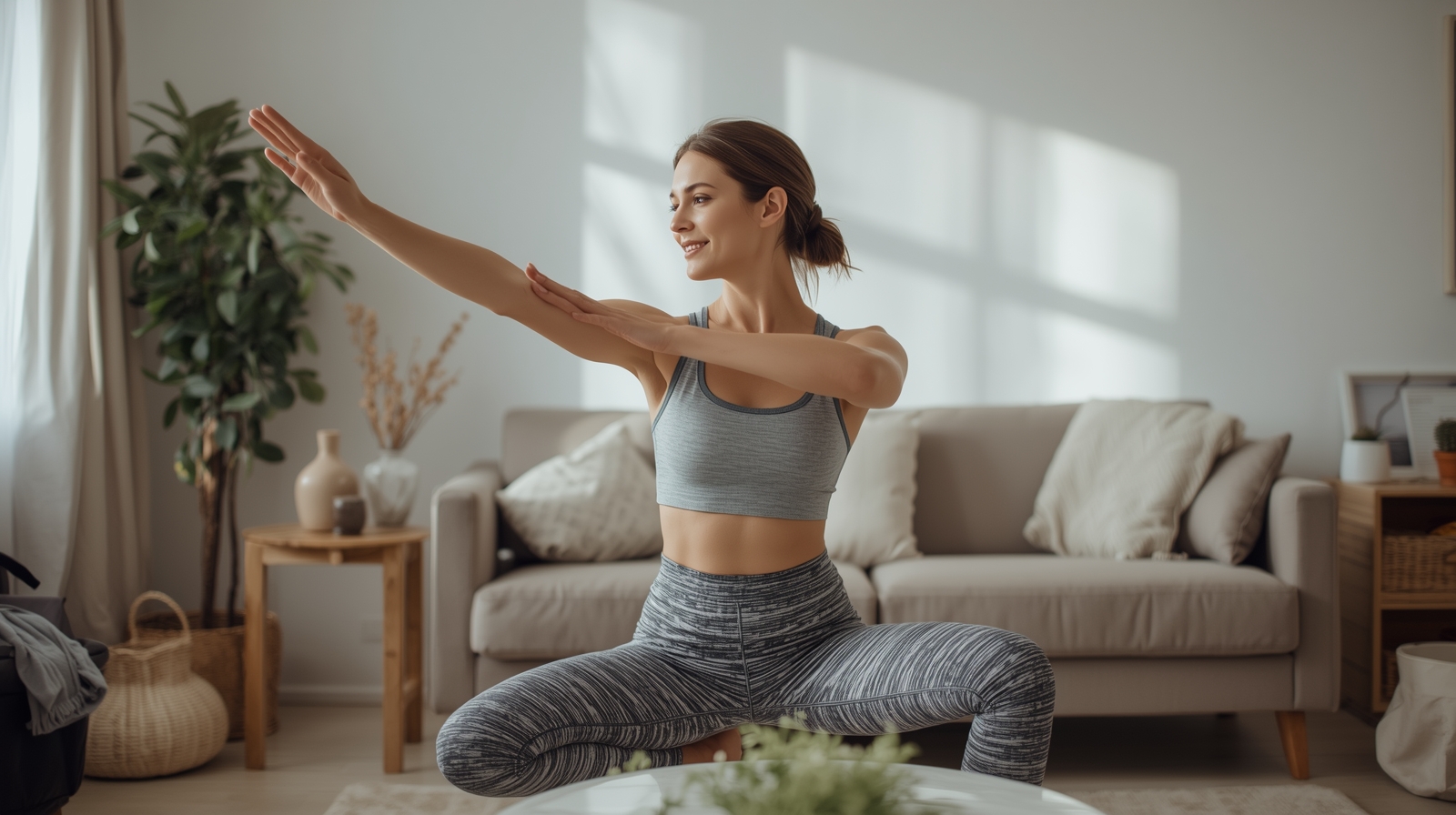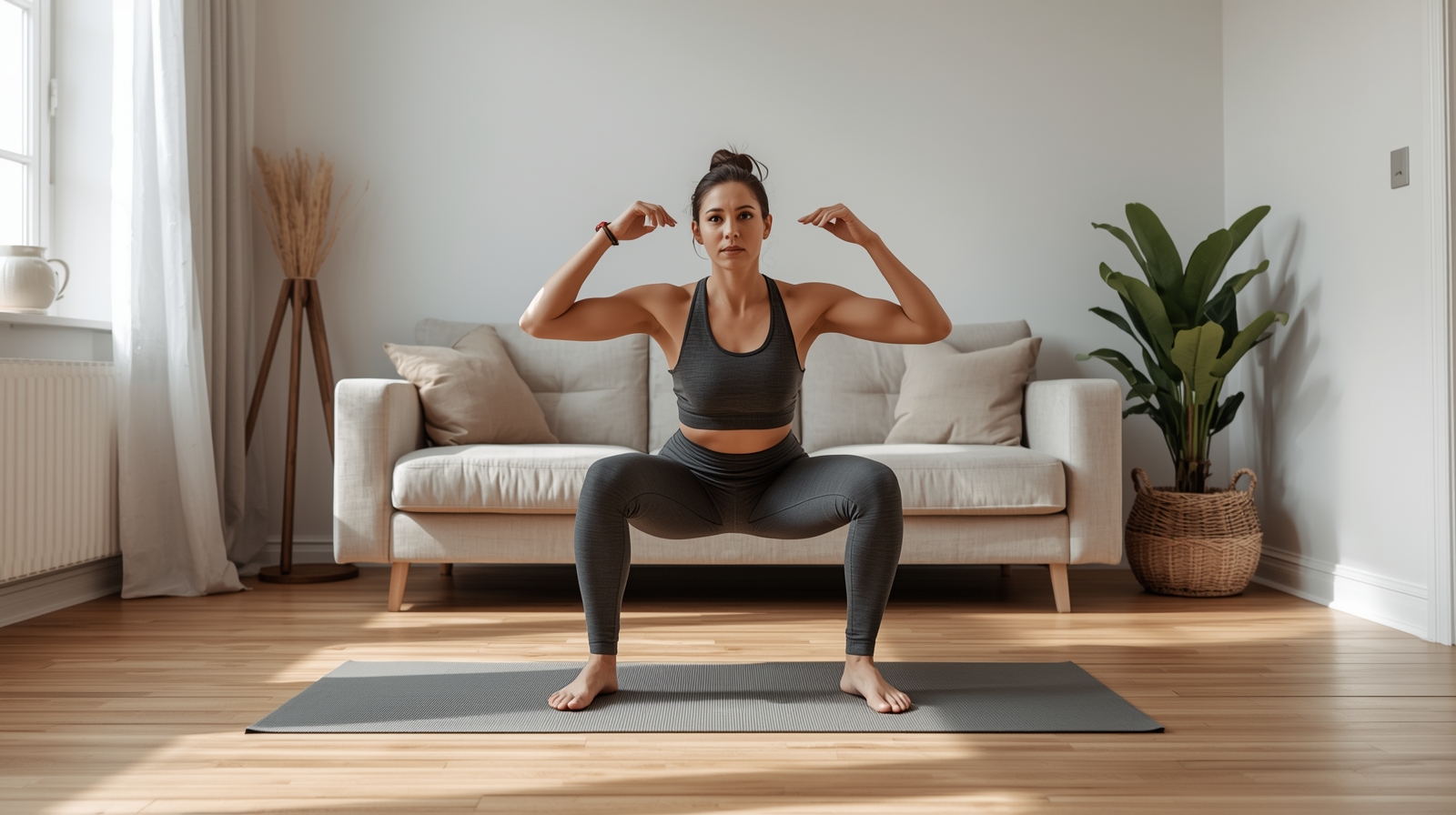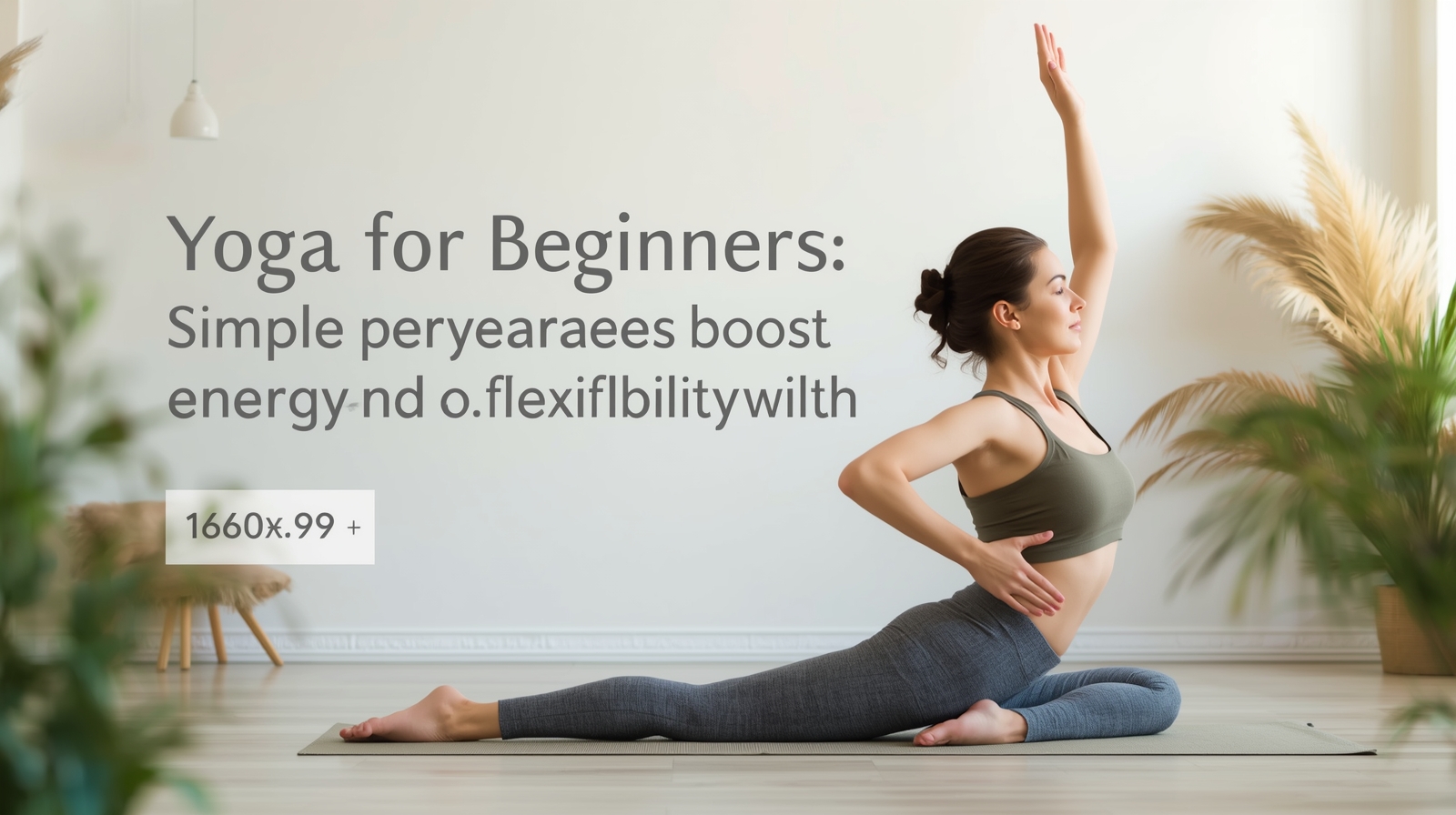Morning exercise has a unique benefit: it sets the rhythm for the entire day. Many women feel pressed for time between work, family, and daily routines. The idea of spending an hour at the gym often feels impossible. A 10-minute workout done at home can be enough to activate the body, improve focus, and maintain consistency.
This guide explains how to build an effective 10-minute workout plan without equipment. The goal is not intensity but consistency and structure. When performed daily, short workouts can improve strength, posture, mobility, and energy levels.
The plan below includes a warm-up, eight functional movements, and a short cool-down. The exercises target the full body—upper, lower, and core—while also providing light cardiovascular activity.
The Purpose of Morning Workouts
A brief morning workout serves several functions:
Metabolic activation: Gentle movement increases circulation and helps the body use stored energy more efficiently through the day.
Consistency: Performing the same short routine at a fixed time makes exercise a habit.
Mental clarity: Movement raises alertness and focus, which improves productivity at work and at home.
Accessibility: No travel time, no gym membership, and no equipment mean fewer barriers to entry.
When a woman trains in the morning, she completes an important self-care task before other responsibilities take over. The sense of completion builds momentum and discipline that often extends into nutrition and lifestyle decisions later in the day.
Structuring a 10-Minute Routine
The 10-minute session can be divided into three parts:
Warm-Up (2 minutes)
Main Circuit (7 minutes)
Cool-Down (1 minute)
Each movement lasts 40–45 seconds, followed by 15–20 seconds of transition. The pace can be adjusted based on fitness level. Beginners can reduce repetitions; advanced users can increase intensity or add an additional round.
- Warm-Up (2 Minutes)
The warm-up prepares muscles, joints, and the cardiovascular system. It also establishes proper breathing rhythm.
Routine:
30 seconds: March in place. Keep arms swinging naturally.
30 seconds: Arm circles. Move forward for 15 seconds and backward for 15 seconds.
30 seconds: Hip rotations. Open hips with controlled circular motion.
30 seconds: Light jogging or side steps. Maintain relaxed shoulders and steady breath.
These simple moves raise body temperature and activate key muscle groups before more demanding exercises.
- Main Circuit (7 Minutes)
The main circuit focuses on compound movements that engage multiple muscle groups. It alternates between strength and cardio patterns to maximize efficiency in limited time.
Exercise 1: Jumping Jacks
Jumping jacks elevate heart rate and engage arms, legs, and core. Begin with feet together and arms at sides. Jump while raising arms overhead and spreading feet slightly wider than shoulders. Return to the starting position and repeat.
Continue for 45 seconds. Move lightly on your feet and breathe rhythmically. If jumping causes discomfort, perform a step-out version by alternating side steps with arm lifts.
Exercise 2: Bodyweight Squats
Squats build strength in the thighs, hips, and glutes. Stand with feet shoulder-width apart. Lower hips as if sitting in a chair, keeping the chest upright and heels grounded. Drive through the heels to stand again.
Perform as many controlled repetitions as possible in 45 seconds. Focus on alignment rather than depth. Squats also improve circulation in the lower body and support mobility in daily tasks.
Exercise 3: Push-Ups
Push-ups strengthen the chest, shoulders, triceps, and core. Begin in a plank position with hands slightly wider than shoulders. Lower the body until elbows reach a 90-degree angle, then push back up.
Beginners can modify by keeping knees on the floor. Maintain a straight line from shoulders to knees or ankles. Proper form is more important than speed.
Exercise 4: Standing Crunches
This movement activates the abdominal muscles without requiring floor space. Stand with feet hip-width apart and hands behind the head. Lift one knee toward the chest while bringing the opposite elbow toward it, engaging the core. Alternate sides for 45 seconds.
Standing crunches are useful for those with limited space or who prefer low-impact options.
Exercise 5: Reverse Lunges
Lunges develop balance and lower-body stability. Stand tall, step one foot backward, and lower both knees until the front thigh is parallel to the floor. Return to standing and switch legs.
Avoid leaning forward or allowing the front knee to pass the toes. Alternate sides for 45 seconds, keeping a steady tempo.
Exercise 6: Mountain Climbers
Mountain climbers combine cardio and core engagement. Start in a plank position. Draw one knee toward the chest, then quickly switch legs in a running motion while keeping hands under shoulders.
Continue for 45 seconds. This movement raises the heart rate and strengthens shoulders, arms, and abdominal muscles simultaneously.
Exercise 7: Glute Bridges
Lie on your back with knees bent and feet flat on the floor, hip-width apart. Press through the heels to lift hips until the knees, hips, and shoulders form a straight line. Pause at the top, then lower slowly.
Repeat for 45 seconds. Glute bridges strengthen the posterior chain—glutes, hamstrings, and lower back—and improve posture.
Exercise 8: Plank Hold
The plank builds core stability and endurance. Begin on forearms or hands with elbows under shoulders. Keep the body in a straight line from head to heels.
Hold the position for 30 to 45 seconds. Avoid letting hips sag or rise. Concentrate on breathing evenly through the nose and mouth.
- Cool-Down (1 Minute)
Cooling down helps the body transition from exertion to rest. It reduces muscle tension and supports flexibility.
Routine:
30 seconds: Forward fold stretch. Keep knees soft and let the upper body hang.
15 seconds per side: Standing quad stretch.
30 seconds: Deep breathing with arms overhead.
These movements help lower heart rate and promote calm focus for the rest of the morning.
Understanding Exercise Mechanics
Each of the eight exercises serves a specific purpose within the 10-minute framework.
Jumping jacks and mountain climbers increase heart rate and calorie use.
Squats and lunges target large muscle groups to enhance lower-body power.
Push-ups and planks strengthen the upper body and core.
Standing crunches improve coordination and trunk control.
Glute bridges reinforce hip alignment and reduce lower-back discomfort from prolonged sitting.
By alternating upper, lower, and core movements, the routine maintains balanced development without fatigue in a single region.
Weekly Progression Plan
Although the session lasts only ten minutes, progress can occur through gradual increases in effort.
Week 1–2: Perform the circuit once daily, focusing on proper form.
Week 3–4: Add a second round of selected movements or shorten rest periods.
Week 5 and beyond: Incorporate small hand weights or resistance bands for added challenge.
Consistency is more valuable than duration. Missing several days has a larger impact than doing fewer repetitions.
Breathing and Posture
Controlled breathing supports stability and endurance. Inhale during the easier phase of the movement and exhale during exertion.
Example:
During squats, inhale while lowering and exhale while rising.
In push-ups, inhale when lowering and exhale when pushing away.
Good posture prevents strain. Keep the neck aligned with the spine, draw shoulders back slightly, and engage the core throughout each exercise.
Time Management for Busy Women
Finding ten minutes may require adjustment of routine. Strategies include:
Wake ten minutes earlier and treat the session as non-negotiable.
Use short breaks between tasks if mornings are impossible; the workout remains effective at any time of day.
Prepare workout clothes the night before to remove decision fatigue.
Track progress using a notebook or mobile app to maintain motivation.
Even minimal planning makes adherence easier. Many women find that once the session becomes habitual, it replaces the need for caffeine or prolonged stretching.
Benefits Beyond Physical Fitness
While the focus is movement, short exercise periods influence many aspects of health.
Energy Regulation: Early exercise improves mitochondrial function, resulting in more stable energy throughout the day.
Stress Management: Movement reduces stress hormones and supports emotional balance.
Bone Health: Weight-bearing exercises such as squats and lunges maintain bone density, which is especially valuable for women as they age.
Cardiovascular Health: Regular activity improves circulation and heart efficiency.
Metabolic Function: Consistent morning workouts help regulate blood sugar and appetite, supporting weight management goals.
The cumulative effect of daily practice surpasses that of sporadic long workouts.
Nutrition After Morning Workouts
Post-workout nutrition supports recovery and energy for the day ahead.
Hydration: Drink a full glass of water after exercise.
Balanced Breakfast: Combine protein, complex carbohydrates, and healthy fats. Examples include oatmeal with yogurt, eggs with whole-grain toast, or a smoothie with fruits and protein powder.
Avoid excessive sugar: It may cause energy spikes and crashes that counteract workout benefits.
Eating within an hour of exercise enhances muscle repair and stabilizes blood sugar.
Common Mistakes to Avoid
Skipping Warm-Up or Cool-Down: Increases the risk of injury and stiffness.
Overexertion: Ten minutes of proper form is more effective than overdoing movements quickly.
Ignoring Pain: Mild discomfort is normal; sharp pain indicates the need to stop.
Lack of Consistency: Occasional workouts deliver limited results. Daily repetition creates adaptation.
Poor Form: Prioritize posture and breathing over speed or number of repetitions.
Recognizing these patterns helps sustain a safe and effective practice.
How to Measure Progress
Progress in short workouts is not only about visible changes. Several indicators show improvement:
Reduced fatigue during daily tasks.
Improved flexibility and range of motion.
Better sleep quality.
Lower perceived stress.
Gradual changes in body composition or clothing fit.
Documenting small improvements maintains motivation and confirms that even brief sessions make a difference.
Integrating 10-Minute Workouts Into a Broader Fitness Plan
Once the 10-minute habit becomes stable, it can form the base of a broader program.
Combine with walks or cycling on alternate days for cardiovascular variety.
Add weekend strength sessions with resistance bands or light weights.
Include mobility or yoga routines once per week to maintain joint health.
The flexibility of a short morning workout makes it compatible with any fitness goal.
Safety Considerations
Before beginning any exercise routine, consult a healthcare provider, especially if there are existing medical conditions or recent injuries.
Maintain an uncluttered area for movement. Use a mat for cushioning if the floor is hard. Avoid slippery surfaces.
Pay attention to hydration, adequate sleep, and recovery time. Even light workouts require rest and balanced nutrition to sustain progress.
Creating a Supportive Environment
Behavioral research shows that environmental cues influence consistency. To maintain the habit:
Keep the mat visible in the morning area.
Set a recurring alarm or calendar reminder.
Play a specific music playlist during workouts to trigger focus.
Engage a friend or family member for accountability.
Small adjustments make it easier to repeat the workout daily without additional decision-making effort.
Example Weekly Schedule
Day Focus Notes
Monday Full 10-minute circuit Establish pace and form
Tuesday Core and balance emphasis Add plank variations
Wednesday Active recovery Light yoga or walk
Thursday Lower-body strength Extra squats or lunges
Friday Cardio focus Include mountain climbers and jumping jacks
Saturday Mixed session Combine all movements
Sunday Stretch and mobility Gentle cool-down routine
This rotation keeps training fresh while covering all major areas of fitness.
Maintaining Long-Term Motivation
Motivation fluctuates, but discipline sustains habits. Use these strategies to remain consistent:
Set realistic goals. Focus on frequency rather than outcome.
Track progress. Simple logs build a sense of achievement.
Recognize triggers. Identify situations that cause skipped sessions and plan alternatives.
Revisit purpose. Remember that exercise supports energy and mood, not only appearance.
Sustainable habits form when reasons are personal and meaningful.



